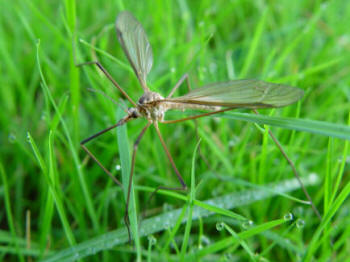Leatherjackets - the larvae of the Cranefly - are normally associated with damage on lawns. However, they can also be a root eating pest on other crops in borders or vegetable plots. Old un-tended allotment plot are particularly vulnerable, though it seems that the adult cranefly prefers an interrupted approach to the soil or grass where the eggs are to be laid.
Leatherjackets are the larvae of Craneflies and they feed upon roots or underground stems such as corms and tubers. They can create havoc with root crops or seedlings in the vegetable garden and also different types of borders.
Nemasys - a biological control - can be used but the leatherjacket grubs can best be dealt with by ordinary cultivation procedures such as digging and hoeing. there are no soil insecticide treatments available.
 If the
ground is empty of crops - such as is often the case on allotments,
then a black plastic sheet can be laid down overnight, and the grubs
will come to the surface, where they can be collected and dispensed
with. A slightly messy affair and not for the
squeamish - though the end result may well help you to overcome any
distaste!
If the
ground is empty of crops - such as is often the case on allotments,
then a black plastic sheet can be laid down overnight, and the grubs
will come to the surface, where they can be collected and dispensed
with. A slightly messy affair and not for the
squeamish - though the end result may well help you to overcome any
distaste!
The adult Cranefly emerges from the soil in late summer, and soon get to work laying eggs in the soil - sometimes within a few days of becoming an adult!
 The eggs hatch into what we know as leatherjacket - though
small at this stage - burrow into the ground and feed on roots and
tubers throughout the autumn. They turn into 'leatherjackets' during
late autumn, then overwinter in the ground, ready to resume feeding on
plant roots as soon as the soil warms up in spring.
The eggs hatch into what we know as leatherjacket - though
small at this stage - burrow into the ground and feed on roots and
tubers throughout the autumn. They turn into 'leatherjackets' during
late autumn, then overwinter in the ground, ready to resume feeding on
plant roots as soon as the soil warms up in spring.
Damage of the roots occurs and becomes noticeable in April - May. Whilst they remain underground in the daytime, they sometimes emerge at night - especially in damp and worm conditions.
Starlings and Blackbirds are happy to forage about in the borders and vegetable plot seeking out the tasty morsels we know and loath as leatherjackets!
Main Page for Apple Tree Problems